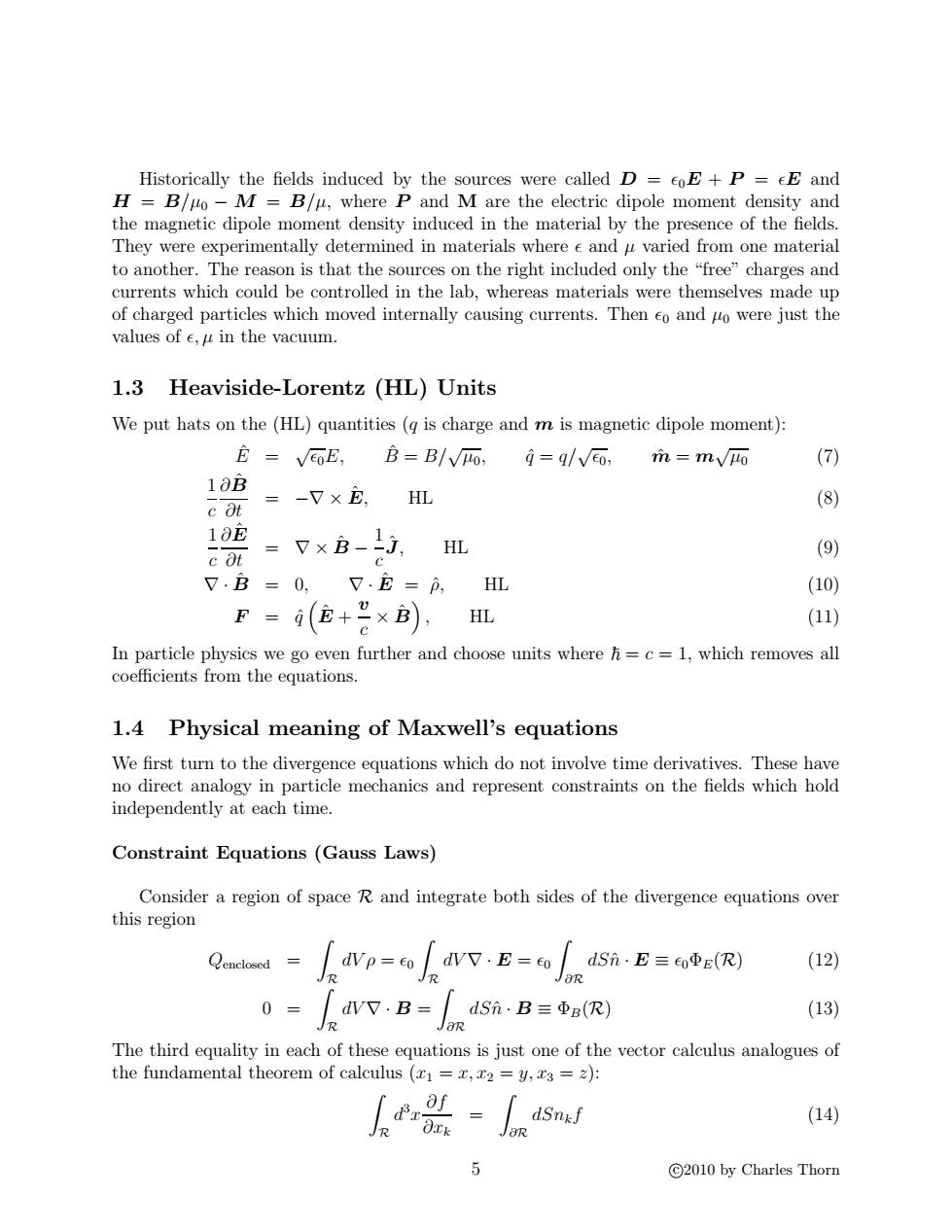正在加载图片...

Historically the fields induced by the sources were called D =EoE+P =EE and H=B/Ho-M B/u,where P and M are the electric dipole moment density and the magnetic dipole moment density induced in the material by the presence of the fields. They were experimentally determined in materials where e and u varied from one material to another.The reason is that the sources on the right included only the "free"charges and currents which could be controlled in the lab,whereas materials were themselves made up of charged particles which moved internally causing currents.Then eo and uo were just the values of e,u in the vacuum. 1.3 Heaviside-Lorentz (HL)Units We put hats on the(HL)quantities (g is charge and m is magnetic dipole moment): E=VEoE,B=B/VH0, 9=q/o (7) 10B =-又×E. HL c Ot (8) 10E =V×B-), HL c Ot (9) 7.B=0, 7.它=p HL (10) F=(E+8xB), HL (11) In particle physics we go even further and choose units where h=c=1,which removes all coefficients from the equations. 1.4 Physical meaning of Maxwell's equations We first turn to the divergence equations which do not involve time derivatives.These have no direct analogy in particle mechanics and represent constraints on the fields which hold independently at each time. Constraint Equations (Gauss Laws) Consider a region of space R and integrate both sides of the divergence equations over this region Qenclosed dvp=Eo dW7·E=o dSn·E三eoΦE(R) (12) R JR 0 dWV·B=dSn.B=Φs(R) (13) The third equality in each of these equations is just one of the vector calculus analogues of the fundamental theorem of calculus (z1=x,2 =y,3 =2): ∂f dr- Tk dSnkf月 (14) 5 ©2010 by Charles ThornHistorically the fields induced by the sources were called D = 0E + P = E and H = B/µ0 − M = B/µ, where P and M are the electric dipole moment density and the magnetic dipole moment density induced in the material by the presence of the fields. They were experimentally determined in materials where and µ varied from one material to another. The reason is that the sources on the right included only the “free” charges and currents which could be controlled in the lab, whereas materials were themselves made up of charged particles which moved internally causing currents. Then 0 and µ0 were just the values of , µ in the vacuum. 1.3 Heaviside-Lorentz (HL) Units We put hats on the (HL) quantities (q is charge and m is magnetic dipole moment): Eˆ = √ 0E, Bˆ = B/ √ µ0, qˆ = q/ √ 0, mˆ = m √ µ0 (7) 1 c ∂Bˆ ∂t = −∇ × Eˆ , HL (8) 1 c ∂Eˆ ∂t = ∇ × Bˆ − 1 c Jˆ, HL (9) ∇ · Bˆ = 0, ∇ · Eˆ = ρˆ, HL (10) F = qˆ Eˆ + v c × Bˆ , HL (11) In particle physics we go even further and choose units where = c = 1, which removes all coefficients from the equations. 1.4 Physical meaning of Maxwell’s equations We first turn to the divergence equations which do not involve time derivatives. These have no direct analogy in particle mechanics and represent constraints on the fields which hold independently at each time. Constraint Equations (Gauss Laws) Consider a region of space R and integrate both sides of the divergence equations over this region Qenclosed = Z R dV ρ = 0 Z R dV ∇ · E = 0 Z ∂R dSnˆ · E ≡ 0ΦE(R) (12) 0 = Z R dV ∇ · B = Z ∂R dSnˆ · B ≡ ΦB(R) (13) The third equality in each of these equations is just one of the vector calculus analogues of the fundamental theorem of calculus (x1 = x, x2 = y, x3 = z): Z R d 3x ∂f ∂xk = Z ∂R dSnkf (14) 5 c 2010 by Charles Thorn